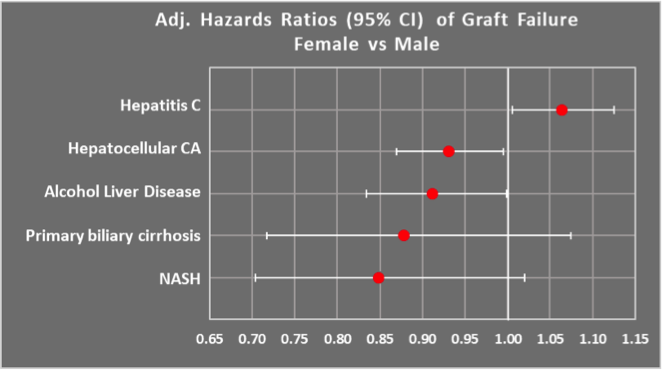Recipient Sex Interacts with Primary Diagnosis to Affect Liver Transplant Graft Survival
1Surgery, University of Colorado, Denver, CO, 2Surgery, Lahey Clinic, Burlington, MA
Meeting: 2019 American Transplant Congress
Abstract number: A303
Keywords: Graft survival, Hepatitis C, Risk factors
Session Information
Session Name: Poster Session A: Liver: Recipient Selection
Session Type: Poster Session
Date: Saturday, June 1, 2019
Session Time: 5:30pm-7:30pm
 Presentation Time: 5:30pm-7:30pm
Presentation Time: 5:30pm-7:30pm
Location: Hall C & D
*Purpose: While recipient sex is a commonly studied risk factor in liver transplantation, findings have been contradictory. We hypothesized that different causes of liver disease portend differential risks for male and female recipients, perhaps accounting for some of the discrepancies in the literature. We aimed to evaluate differences in risk for graft loss following liver transplantation by recipient sex and primary liver disease.
*Methods: The 2002-2017 UNOS database was queried for all primary liver-only transplants. We evaluated the effect of recipient sex and primary liver disease on graft survival adjusted for characteristics of the recipient (age, race/ethnicity, BMI, prior abdominal surgery, MELD score, albumin, mechanical ventilation, portal vein thrombosis, dialysis, status 1), and donor (age, sex, sex-mismatch, blood type, national allocation). Cox proportional regression (CPR) was used to select independent predictors (stepwise selection), test interactions between recipient sex and primary disease and derive adjusted hazard ratios (AdjHR).
*Results: 27,141 females (33%) and 54,825 males (67%) underwent a first liver transplant during the study period. One, five, and ten-year graft survival rates were 86%, 73%, and 60% for females and 87%, 71%, and 57% for males. After adjustment for independent predictors, recipient female sex conferred a graft survival benefit (AdjHR:0.88; 95% CI:0.86-0.91, p<0.0001). A significant interaction between sex and primary disease was detected (p<0.0001) indicating that sex modified the risk associated with specific primary diseases. Separate CPR models for the most common primary diseases demonstrated that recipient female sex was significantly protective in alcoholic liver disease (AdjHR:0.91, 95%CI:0.83-0.99, p=0.046) and hepatocellular carcinoma (AdjHR:0.93, 95% CI:0.82-0.99, p=0.035), but significantly detrimental in hepatitis C cirrhosis (AdjHR:1.06, 95%CI:1.01-1.13, p=0.031).
*Conclusions: The impact of recipient sex on liver transplant graft survival varies depending on the primary cause of liver disease. While female sex is protective against graft loss in alcoholic liver disease and hepatocellular carcinoma, it is associated with increased risk in hepatitis C cirrhosis. Additional work to characterize the mechanisms of these sex-related survival differences is essential in order to identify modifiable factors that may be addressed to improve outcomes.
To cite this abstract in AMA style:
Yoeli D, Choudhury R, Moore H, Simpson M, Sauaia A, Pomfret E, Nydam T. Recipient Sex Interacts with Primary Diagnosis to Affect Liver Transplant Graft Survival [abstract]. Am J Transplant. 2019; 19 (suppl 3). https://atcmeetingabstracts.com/abstract/recipient-sex-interacts-with-primary-diagnosis-to-affect-liver-transplant-graft-survival/. Accessed December 25, 2025.« Back to 2019 American Transplant Congress

